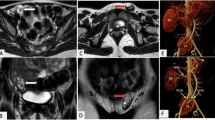Abstract
This is an 18-year (1985–2001) retrospective review of 85 patients with true hermaphroditism, with the aim of facilitating early recognition of this condition. Presentation of neonates and infants 6 months or younger, constituting 54% of this cohort, were different from the older children. The presentation, clinical features and investigative results of all patients diagnosed with true hermaphroditism at a single South African paediatric surgical unit were reviewed. This paper highlights the previously reported high incidence (51%) of this condition, as well as some of the unusual features of true hermaphroditism in this region. Diagnosis of true hermaphroditism requires a high index of suspicion for subtle anomalies of the genitalia. Although there were no pathognomonic clinical features, the true hermaphrodite presents as a patient of either gender with a congenital anomaly of the genitalia. The child is likely to have a normal male phallus, bifid labio-scrotal folds, a perineal hypospadias and in 53% of patients there was a palpable gonad. The method of investigation, together with the results and some of the management dilemmas associated with true hermaphroditism in a Third World population are presented.






Similar content being viewed by others
References
Kristic ZD, Smoljanic Z, Vukanic D et al. (2000) True hermaphroditism: 10 years experience. Pediatr Surg Int 16:580–583
Niekerk WA van (1976) True hermaphroditism. An analytical review with a report of 3 new cases. Am J Obstet Gynecol 126:890–907
Wiersma R (1998) The African ovotestis: hidden histology. Presentation to South African Association of Paediatric Surgeons 14th Biennial and World Federation of Associations of Pediatric Surgeons Combined Congress
McGillivray BC (1992) Genetic aspects of ambiguous genitalia. Pediatr Clin North Am 39:307–317
Wiersma R, Constantinides CG (1993) True hermaphroditism: a common cause of intersex in Africa. S Afr J Surg 31:360
Ramsay M, Bernstein R, Zwant E et al. (1988) True hermaphroditism in southern African blacks: an enigma of primary sexual differentiation. Am J Hum Genet 43:4–13
Aaronson IA (1985) True hermaphroditism. A review of 41 cases with observations on testicular histology and function. Br J Urol 57:775–779
Nimkarn S, Likitmaskul S, Sangacharoenkit P et al. (2002) Ambiguous genitalia: an overview of 22 years experience and the diagnostic approach in the pediatric department, Siriraj Hospital. J Med Assoc Thai 85 [Suppl 2]:S496–505
Krob G, Braun A, Kuhnle U (1994) True hermaphroditism: geographical distribution, clinical findings, chromosomes and gonadal histology. Eur J Pediatr 153:2–10
Reiner WG (1999) Assignment of sex in neonates with ambiguous genitalia. Curr Opin Pediatr 11:363–365
Wiersma R (2001) Management of the African child with true hermaphroditism. J Pediatr Surg 36:397–399
Author information
Authors and Affiliations
Corresponding author
Rights and permissions
About this article
Cite this article
Wiersma, R. True hermaphroditism in southern Africa: the clinical picture. Ped Surgery Int 20, 363–368 (2004). https://doi.org/10.1007/s00383-004-1200-0
Accepted:
Published:
Issue Date:
DOI: https://doi.org/10.1007/s00383-004-1200-0




